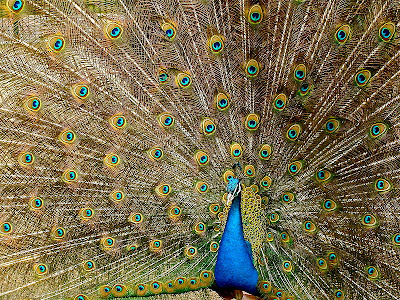A.
319. How many individual parts does a feather
have?
The parts of a single feather add up to more than a million individual units, many of them so small they can only be seen with the help of a microscope. These parts interlock to form an extremely strong, light plane of great flexibility.
The parts of a single feather add up to more than a million individual units, many of them so small they can only be seen with the help of a microscope. These parts interlock to form an extremely strong, light plane of great flexibility.
321. Are the feathers of a bird alive?
As long as the feather is growing, its soft central is fed with blood vessels which supply pigments and food. Once the feather is fully mature, that is, has lost all of its sheath and is fully expanded, it hardens, the food supply is cut off, and the whole structure is made up of dead epidermis. The feather may then be considered dead, though it continues to be firmly clasped by the feather follilcle until the next
E.
As long as the feather is growing, its soft central is fed with blood vessels which supply pigments and food. Once the feather is fully mature, that is, has lost all of its sheath and is fully expanded, it hardens, the food supply is cut off, and the whole structure is made up of dead epidermis. The feather may then be considered dead, though it continues to be firmly clasped by the feather follilcle until the next
molt.
D.
E.
326. What are down feathers?
These are soft feathers without a shaft and having barbs that are but soft fluffy tufts. They are extremely strong and resilient. They provide the covering of many newly-hatched birds , particularly those of the precocial group. Some species of birds as adults have a down undercoating beneath their contour feathers. Ducks and geese have such an undercoating.
These are soft feathers without a shaft and having barbs that are but soft fluffy tufts. They are extremely strong and resilient. They provide the covering of many newly-hatched birds , particularly those of the precocial group. Some species of birds as adults have a down undercoating beneath their contour feathers. Ducks and geese have such an undercoating.
F.
327. What are powder-down feathers?
H.
I.
These
scarcely seem like feathers at all. They
form a powdery substance on some areas of the skin of such birds as herons and
bitterns. These birds rub their bills in
the powder-down feathers and spread the resulting powder over their plumage,
giving it a “bloom” which rubs off when the bird is handled.
H.
I.
Key to Illustrations:
A. Indian peacock photographed by Jebulon.
B. Feather structure diagram.
C. Parts of the feather: (1) Vane; (2) Rachis; (3) Barb; (4) After-Feather; (5) Hollow shaft (calamus)
D. Feather structure of a blue-and-yellow Macaw.
E. Common female eider duck with down photographed by Frederic Levier.
F. Plumes. Illustré par Adolphe
Millot dans Larousse pour tous [1907-1910]. Aigle, Hibou, Goura,
Argus, Paon, Autruche, Canard, Dindon, Pintade, Aigrette, Faisan etc.
G. Mealy parrot showing powder down, photographed in Florida by Don Kasak.
H. Archaeopteryx sometimes
referred to by its German name Urvogel ("original
bird" or "first bird"), is a genus of theropod dinosaur. Late Jurassic Period (150 million years ago).
I. Shaft of male Indian Peafowl tail feather (Pavo
cristatus); Feather microstructure showing interlocking
barbules. Photographed by Michael Maggs.
From: 1001 Questions Answered About Birds by Allan D. Cruickshank
and Helen G. Cruickshank (Toronto, General Publishing Company, 1958)











No comments:
Post a Comment